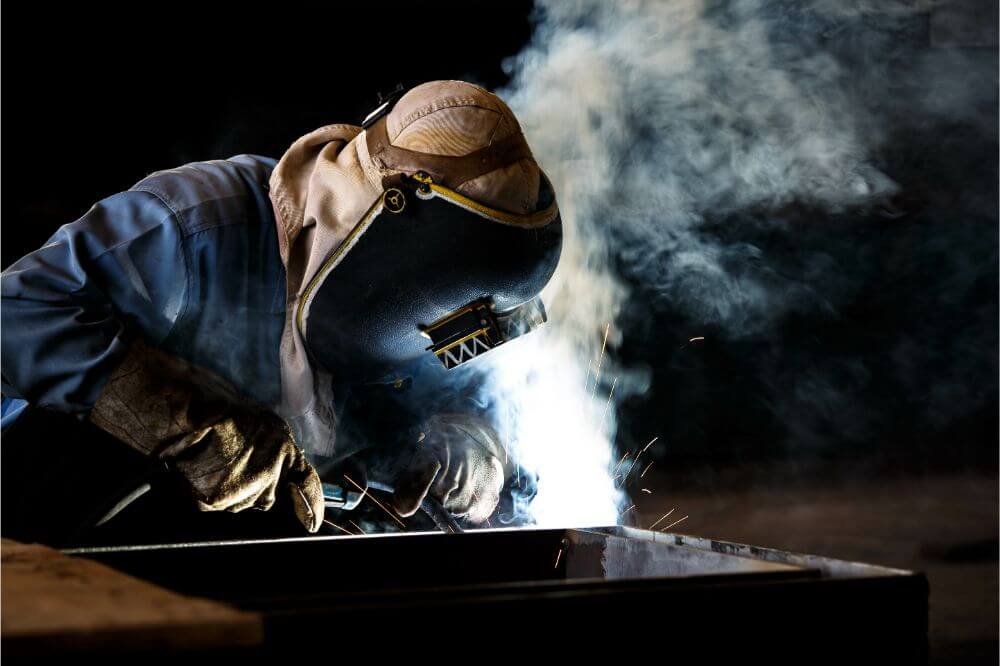Welding is an essential process for many industries, and there are various welding techniques available.
Two of the most commonly used methods are flux core vs MIG welding.
Flux core welding is a process of arc welding, where a tubular wire with a flux-based core is used, as opposed to a solid wire.
MIG welding, which stands for Metal Inert Gas, uses a continuous solid wire electrode that is fed through a welding gun.
Both welding techniques have their own advantages and disadvantages, and it is important to understand these before deciding which is the most suitable technique for your needs.
In this article, we will discuss the differences between flux core and MIG welding, their advantages and disadvantages, and compare these two processes.
Advantages of Flux Core Welding
When it comes to welders, flux core and MIG welding are two of the most popular types. But which one should you choose? Understanding the advantages of each can help you make an informed decision.
Flux core welding has several advantages, including the fact that it doesn’t require a shielding gas, which can be expensive and difficult to transport. It also works well in outdoor environments, as the wind direction won’t affect the quality of the weld.
Plus, it’s a lot faster than other welding methods, as it can deposit more metal in less time.
In comparison, MIG welding has the advantage of being able to use a wide variety of wire types, which gives it more versatility. It also produces less spatter and can be used with thicker materials than other types of welding. Additionally, MIG welding is fairly easy to learn and use, so even beginners can learn it quickly.
By learning about the advantages of flux core and MIG welding, you can make an informed decision about which one is best for your project.
Advantages of MIG Welding
MIG welding, also known as Gas Metal Arc Welding (GMAW), is the most common welding process among hobbyists, DIYers, and professionals alike. When comparing flux core and MIG welding, it’s important to consider the advantages of MIG welding.
One major advantage of MIG welding is its flexibility. It can be used on most metals, including steel, aluminum, and stainless steel. It’s also incredibly versatile, as it’s capable of welding in all positions, including vertical, horizontal, and overhead. This makes it an ideal choice for complex projects that require welding in difficult positions.
MIG welding also offers a high-quality weld. The process uses a shielding gas to protect the weld from contaminants in the atmosphere, which helps to create a stronger, cleaner weld. It also offers a higher deposition rate than flux core welding, meaning it can complete larger projects more quickly and efficiently.
MIG welding also requires less cleanup than flux core welding, as it produces fewer spatter and slag deposits. The process also allows you to use a wider variety of filler materials, giving you more control over the finished weld.
Finally, MIG welding is a relatively safe process. It doesn’t produce any harmful fumes or gases, and the shielding gas helps to protect the welder from UV radiation. Plus, its portability makes it an ideal choice for welding on-site.

Disadvantages of Flux Core Welding
When it comes to Flux Core welding, there are a few downsides to consider. It is important to note that the flux core process produces more smoke, splatter, and sparks than MIG welding does. This makes it harder to see the weld puddle, and the smoke and splatter can be hazardous for both the welder and those in the vicinity.
It is also more difficult to achieve clean welds with flux core compared to MIG welding due to the slag that is produced during the welding process. Slag is a product of combustion that needs to be cleaned off the weld surface, which can be time-consuming.
Furthermore, flux core welding requires a much higher voltage and amperage than MIG welding, so it is not as suitable for thin materials. Finally, flux core welding is more prone to porosity, resulting in weaker welds that may need to be reworked.
Disadvantages of MIG Welding
MIG welding has some disadvantages that can make it a less attractive choice than flux core welding. The most significant disadvantage is cost. MIG welders are typically more expensive than flux core welders and require additional accessories such as a shielding gas, a gas cylinder and a gas hose.
MIG welding also requires a higher degree of skill than flux core welding. This makes it a better choice for experienced welders and limits its use to those who are willing to spend time learning the technique.
Additionally, MIG welding is more limited in its ability to weld thicker materials than flux core welding. It may require multiple passes to weld thick materials which can be time consuming and require more skill.
Finally, MIG welding requires a more involved setup process than flux core welding due to the need to connect the gas tank and set the gas flow correctly. This can make it a less attractive choice for those who are looking for a quick and easy welding process.
Comparison of Flux Core and MIG Welding
When comparing flux core and MIG welding, understanding the differences between the two processes is important.
Flux core welding requires a special type of wire that has been filled with flux, whereas MIG welding requires a shielding gas to protect the weld from the atmosphere. While both processes have their advantages and disadvantages, there are some key differences between flux core and MIG welding.
The first difference is that flux core welding is more forgiving than MIG welding. Flux core welding is ideal for use in outdoor applications where the wind can disrupt the shielding gas of MIG welding. It is also easier to use in cramped or awkward places, such as inside corners or around pipes, where the shielding gas cannot reach.
Additionally, flux core welding produces less spatter than MIG welding, making the process less messy and easier to clean up.
On the other hand, MIG welding offers higher welding speeds and deeper penetration than flux core welding. Additionally, MIG welding is more precise and produces more aesthetically pleasing welds than flux core welding.
Furthermore, MIG welding produces less smoke and fumes than flux core welding, making it a safer option for indoor welding applications.
Ultimately, the choice between flux core and MIG welding comes down to the type of application and the desired outcome. For outdoor applications, flux core welding is the preferred option due to its ability to withstand windy conditions.
For indoor welding applications, MIG welding is the better option due to its higher welding speeds and cleaner welds.
Conclusion
Flux core wire and MIG welding are both effective methods of welding and each has its own advantages and disadvantages.
It is important to consider the type of welding project, budget and skill level before deciding which one is right for you.
Flux core welding is an effective solution for outdoor projects since it does not require an external gas source, but MIG welding is a better choice for precision welding due to its superior control and accuracy.
Ultimately, the decision should be based on your own unique needs and preferences.

